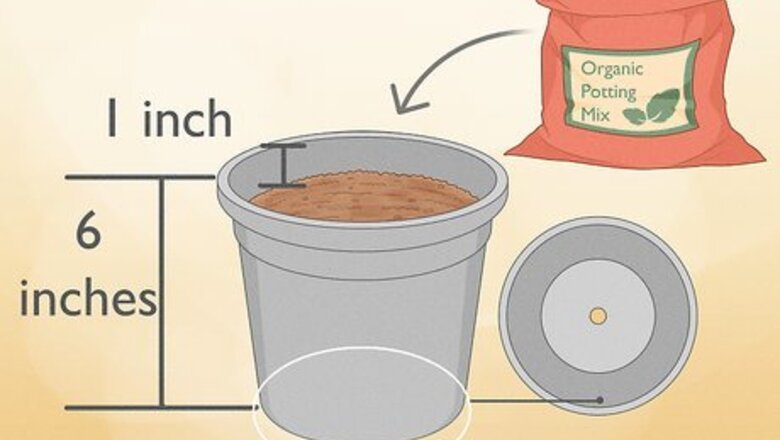
views
- Take cuttings from your plant by trimming off healthy sections of the stem, leaves, or roots, and replanting them in organic potting mix.
- Divide plants with bulbs or rhizomes by digging them up and pulling the roots gently apart by hand. Replant the divisions immediately in a pot or in the ground.
- Bury branches on low-growing plants so the tip of the branch still sticks out from the ground. Let the plant grow new roots on the buried section before cutting it off.
Taking Cuttings
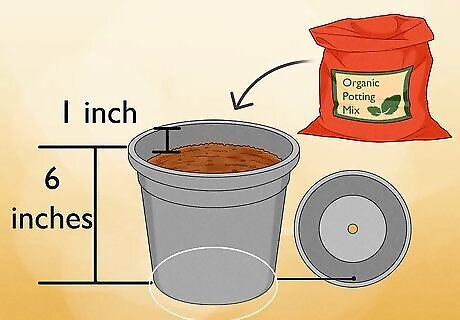
Fill a pot or seedling flat with a well-draining potting mix. When you’re only propagating a few cuttings, choose a 6 in (15 cm) flower pot. Alternatively, a seedling flat works well for smaller leaf cuttings. No matter what container you use, make sure it has drainage holes so excess moisture can drain out. Fill the pot or flat with an organic potting mix so it’s about 1 inch (2.5 cm) below the edge. If you want to make your potting mix for cuttings, mix equal parts compost, vermiculite, and peat moss.
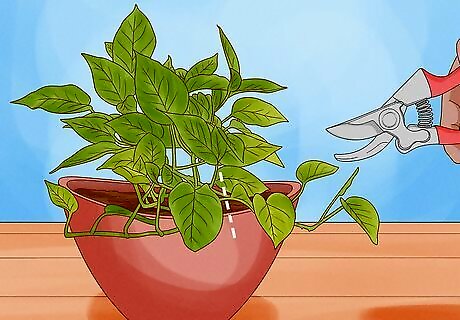
Take a cutting from stems, leaves, or roots from the current growing season. Take your cutting while your plant is actively growing so it’s more likely to develop roots. Put on a pair of gardening gloves and use a clean pair of clippers for your cutting. The main places to take cuttings are from the stem, leaf, or roots, but the location and size of the cutting depends on the type of plant you’re propagating. Stem cuttings: Find a solid, healthy 3–4 in (7.6–10.2 cm) stem that grew in this season. Make a diagonal cut just below one of the nodes where a leaf grows. Stem cuttings work great for plants like aloe, pothos, monstera, hoya, poinsettia, philodendron, and spider plants. Leaf cuttings: Cut off a leaf as close to the stem as you can. Some plants may also need 1 ⁄2 in (3.8 cm) of the stem as well as the leaf. Leaf cuttings work best for African violets, begonias, jade, snake plants, and succulents. Root cuttings: Dig up and cut off a 2–6 in (5.1–15.2 cm) section of healthy roots. Root cuttings are great for woody plants like raspberry, roses, trumpet vine, fig, and lilac.
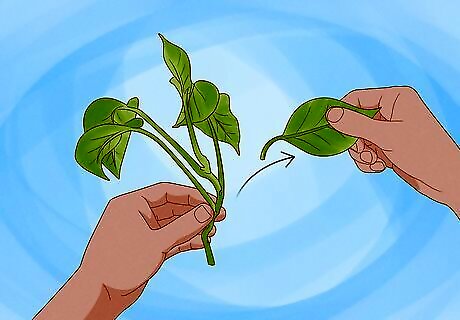
Prepare your cuttings to help encourage healthy growth. Plant cuttings may not put their energy into growing new roots without a little encouragement first. For stem and leaf cuttings, rooting hormone helps new roots form so the plant can reestablish itself. Root cuttings need to stay cool and moist before they’re planted so they don’t dry out. Stem cuttings: Strip off any flowers, buds, or fruit, and remove ⅔ of the leaves from the bottom of the cutting so the plant puts its energy into growing roots. Cut a 1 in (2.5 cm) incision into the base of the stem. Dip the bottom of the stem into rooting hormone. Leaf cuttings: Let the bottom of the leaf cutting dry out and callus over for 1 hour to prevent root rot. Dip the part of the leaf that was closest to the stem into rooting hormone. Root cuttings: Store the root cutting in moist sawdust or peat moss at 40 °F (4 °C) for 3 weeks to help encourage new root growth.
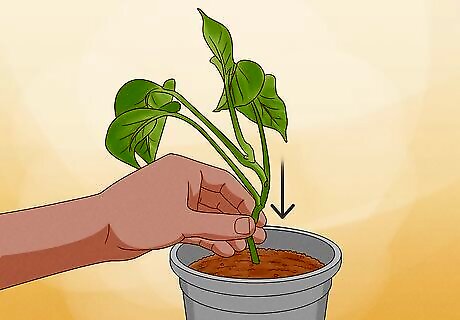
Insert the cutting into the potting mix. For a stem cutting, push about a third of the stem into the potting mix so the buds point upward. With a leaf cutting, just stick the base vertically into the potting mix so the cut end is buried. If you took a root cutting, position large-diameter roots vertically so they’re 2–3 inches (5.1–7.6 cm) below the surface and small-diameter roots horizontally under ⁄2 inch (1.3 cm) of potting mix. Make sure you don’t place your cutting in the pot upside-down, or else it will not propagate or grow properly.
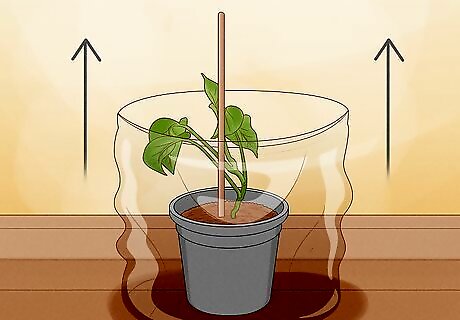
Place both the pot and the cutting into a plastic bag. Put gardening stakes into the potting mix to keep the plastic bag from touching your plants while they’re growing. Put your pot into a large, clear plastic bag and tie it closed to trap in the moisture and humidity. Cuttings can’t take up water from the potting mix since they don’t have roots yet, so the bag helps your plants retain moisture. Some seedling mats come with plastic covers that snap on so you don’t need a plastic bag.
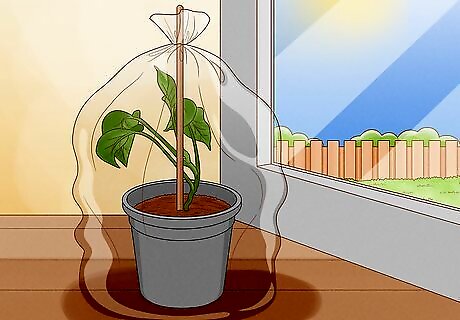
Keep your cutting in a bright, warm area out of direct sunlight. Choose a south- or east-facing window and place the bag with your cuttings there. Maintain a temperature around 70 °F (21 °C) to grow your cuttings and establish roots. Avoid putting your cuttings in direct sunlight because it can stress your plants and cause them to burn or drop leaves.
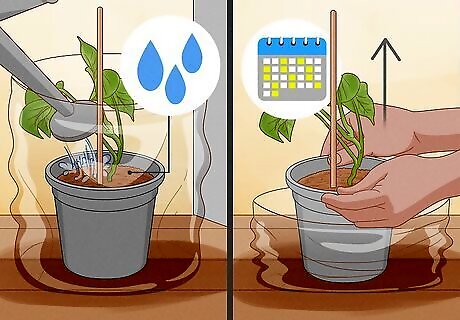
Moisten the potting mix every few days if it dries out. Take the pot out of the bag every 2–3 days and check if the potting mix feels damp to the touch. If the mix feels dried out, use a spray bottle or watering can to lightly wet it. Let the water come out of the container’s drainage holes before putting the bag back on. If the bag has water pooling in the bottom, empty it out before putting the container back inside.
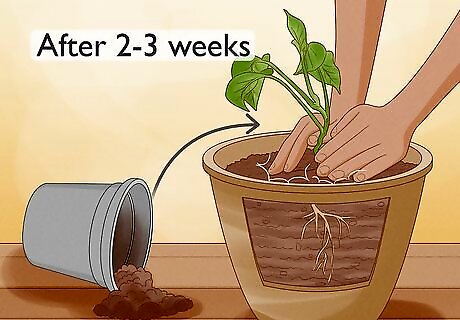
Transplant the cutting after 2–3 weeks when it grows roots. Gently work your hand underneath the cutting and lift it up from the potting mix to see if roots have formed. Once you see roots, keep the plastic bag untied to decrease the humidity. Then, fill a new pot with moist potting mix and transplant your cutting to its new home. If you don’t see roots yet, place the cutting back in the container and compact the soil around it. Put the bag back on, retie it, and check for roots again in 1–2 weeks.
Propagating through Division
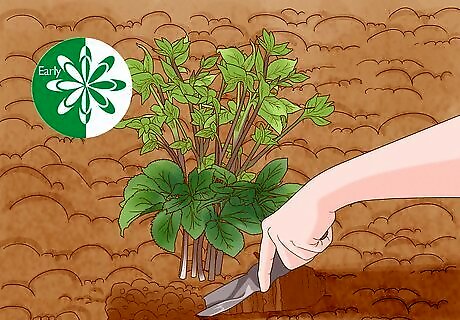
Dig up your plant to propagate them in the early spring. Dividing plants works best just before the start of the growing season. Wait until a cloudy, overcast day to carefully loosen the soil around your plant with a shovel or trowel. Try to shake as much excess soil off of the roots as you can. Lay the plant on its side on a clean, flat surface. Propagation through division works best for plants like aloe, spider plant, orchids, ZZ plant, peace lily, palms, and ferns. Even though plants propagate best in the early spring, you can effectively divide most houseplants at any point during the year.
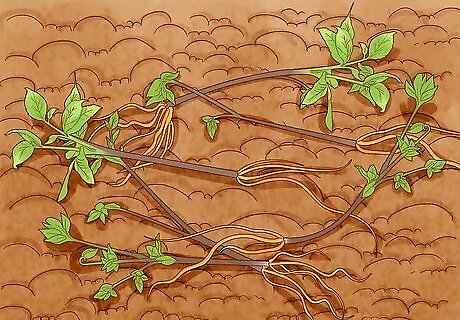
Pull or cut the roots apart into sections with 3–5 shoots. Look for where the bulbs or roots naturally separate and gently try teasing the roots apart with your hands. If you’re not able to pull them apart, then cut them apart with a sharp gardening knife or spade. Make sure each division has a few shoots and a healthy root system so the plant reestablishes. Dividing your plant is also a great way to control its size so it doesn’t rapidly spread.
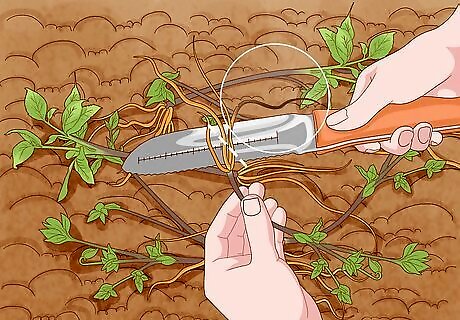
Trim off dead and broken roots with a gardening knife. Carefully inspect the root system of each division you took from the plant. If you notice any roots that are dried, shriveled, or broken, slice them off at the base with your knife. Only leave behind healthy, unbroken roots so your divisions grow with less risk of disease. Be sure to disinfect your gardening knife with rubbing alcohol between plants so you don’t spread any bacteria or diseases between them. If the entire bulb or root system feels soft or mushy, avoid replanting it.
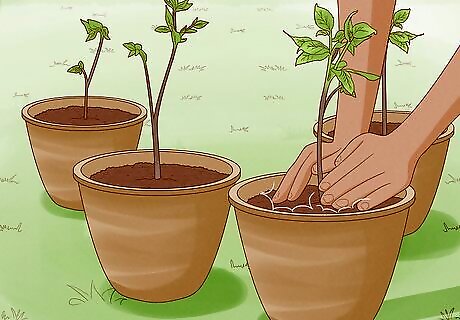
Replant the divisions immediately in containers or in the ground. Prepare a patch of soil in your yard for planting, or fill containers with potting mix for your divisions. Plant the divisions at the same depth as they were when you first dug them up, and fill in the soil around them. Pat the soil down and give it a quick water to get rid of air pockets. After that, just take care of your plant like normal throughout the season. Avoid planting all the divided plants back into the same spot you originally dug up because you may overcrowd them. If you don’t have space for extra plants, ask your friends if they want any of the divisions you just took. If you don’t plan on planting the divisions right away, put them in a pail of water to keep them moist.
Layering
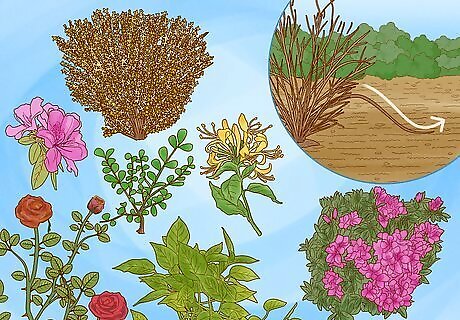
Bend a long flexible branch against the ground. Wait until the early spring or late summer to propagate by layering. Look for a long mature stem on your plant that’s growing close to the ground. Carefully bend the stem down so it’s lying on top of the soil without breaking or snapping. Layering works best for low-growing plants with vine-like branches, like climbing roses, forsythia, rhododendron, honeysuckle, boxwood, pothos, wisteria, and azaleas.
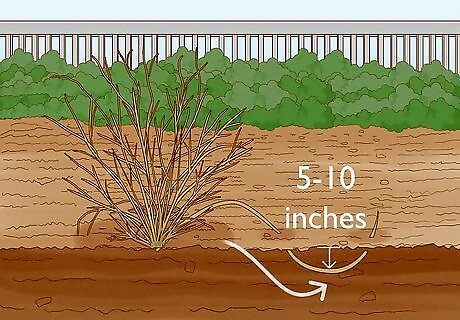
Bury the middle of the branch so 5–10 in (13–25 cm) of the tip sticks out. Measure about 5–10 inches (13–25 cm) from the tip of the stem you’re propagating. Remove any leaves and pile soil onto the stem toward the base of the plant until you cover about 6 inches (15 cm). Compact the soil and bend the tip of the branch upward so it continues to grow. Continue taking care of your plant as normal. If you don’t have any excess soil, set a heavy stone on the stem so it’s held against the ground. To help encourage the stem to grow roots even more, make a small notch or slit in the branch with a gardening knife before you bury it.
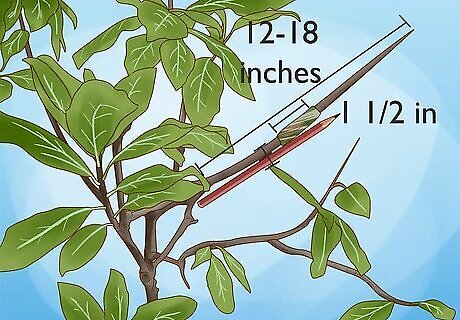
Try air layering trees or large woody plants. Air layering lets your plant establish roots from a branch growing above the ground. Look for branches that are about the same diameter as a pencil and measure 12–18 inches (30–46 cm) from the tip. Cut a ring of bark off of the branch that’s about 1 ⁄2 in (3.8 cm) wide to expose the wood underneath. Cover the exposed wood with damp sphagnum moss and wrap it with plastic sheeting. Secure the ends of the sheeting with electrical tape. The sphagnum moss helps encourage the branch to form roots. If the moss ever dries out, open the plastic sheeting and pour in a little more water. Air-layering works best for plants like magnolia, fig, azaleas, camellias, holly, and fruit trees.
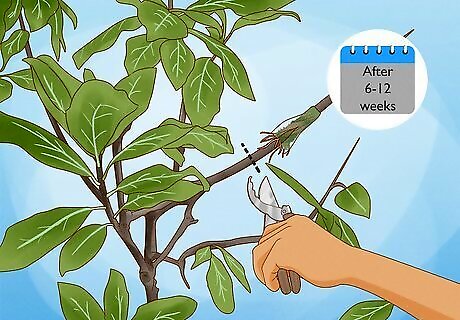
Cut the stem from the parent plant when roots develop in 6–12 weeks. If you’re layering by burying the branch, loosen the soil after 6 weeks to check for roots growing from the branch. If you see some, then use pruning shears to cut the stem that’s connecting to the parent plant. If you were air-layering, cut the stem just below the bottom edge of the plastic. After that, move your propagated plant into a pot or into a new permanent spot in your yard. If you don’t see any roots developing, bury the stem again and check again in another 1–2 weeks. In some cases, it may take 1–2 growing seasons for the layer to establish strong roots and be removed from the parent plant.
Grafting

Wait until the dormant period in winter to graft your plants. Grafting is taking the stem from one plant and attaching it to the rootstock of another plant. Once your plants go dormant or drop their leaves, start grafting your plants so they can get more established during the next growing season. Grafting works best for fruit trees when you want to preserve the flavors and qualities of the fruit.
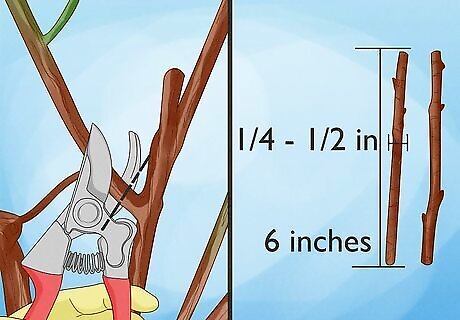
Collect 6 in (15 cm) pieces of wood from the plant you’re propagating. Choose branches or stems (also known as “scions”) from the last growing season rather than mature branches because they’re more likely to propagate successfully. Choose straight pieces that are about ⁄4–⁄2 in (0.64–1.27 cm) in diameter and have multiple buds growing on them. Use a pair of garden clippers to trim the pieces off of the existing plant. Avoid cutting scions from plants that are older than 8–10 years because they’re more likely to have pollen-borne viruses. Store the scions in a plastic bag with moistened paper towels until you graft them so they don’t dry out.
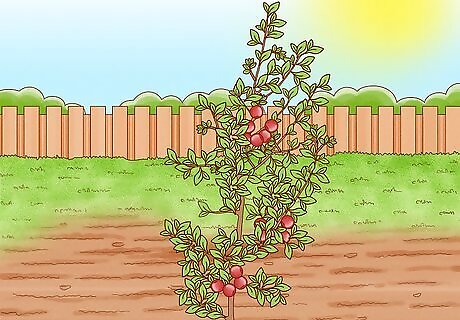
Find a compatible rootstock for your graft. Try to use a rootstock that’s the same type of plant, but a different variety to get the plant characteristics you want. You may grow your own plants to use as rootstocks or check with your local plant nursery to see if they have any rootstocks available. For example, you may use a Bud.9 rootstock for apples to help them be more resistant to rot and cold. If you’re not sure what rootstock to use for your plants, talk to an employee at your local plant nursery to help you find one that works.
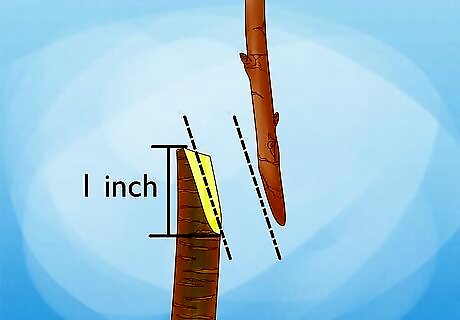
Make 1 in (2.5 cm) sloping cuts on the ends of the scion and rootstock. Take a sharp gardening knife and slice the bottom end of the scion on a diagonal. Then, make the same cut at the top of the rootstock. Then, cut a 1 in (2.5 cm) vertical slit on the ends of the scion and rootstalk. The cuts expose the wood and can help make your graft more successful because the scion and rootstock can grow together.
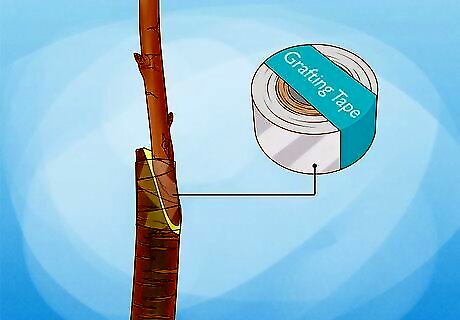
Join the cut ends of the scion and the rootstock with grafting tape. Fit the sloping cuts of the scion and rootstock together so the exposed wood touches. Take a piece of grafting tape and tightly wrap it around the branch to seal it. Leave the grafting tape on the branch while you take care of the plant so the scion and rootstock combine into a single piece. Grafted branches usually take about 1–2 years to fully grow in.




















Comments
0 comment